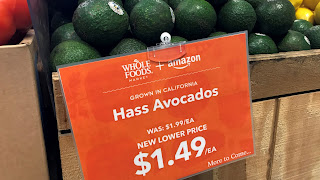 |
| [Whole Foods and Amazon]. (n.d.). Retrieved from https://slickdeals.net/blog/ wp-content/uploads/2017/06/wholefoodsamazonfinal.jpg |
On June 16, 2017, internet giant Amazon announced that it
would acquire organic grocery store Whole Foods for $13.7 billion (Turner, Wang, & Soper, 2017). Although
somewhat surprising, many consumers, myself included, saw this as a natural
extension of a rapidly growing company. Although originally an online shopping
platform for books, movies, and CD’s, Amazon’s reach has since stretched into
everything from food and clothing to music streaming and the production of its
own television shows and movies. Amazon’s multi-channel marketing and wide
range of products often allows them to lower prices while still making a
profit, as they will at Whole Foods (Levy, 2017). Consumers who are
primarily concerned with economic value will certainly appreciate this change (Babin
& Harris, 2016, p. 29).
 |
| [Avocados at Whole Foods]. (n.d.). Retrieved from
https://qzprod.files.wordpress.com/2017/08/
amazon-whole-foods-meat.jpg?quality=80&strip=all&w=4032
|
However, the
most interesting part about Amazon’s acquisition of Whole Foods is the fact
that an exclusively online retailer has now merged with a retailer that
primarily operates in-store. This will inevitably change the consumer
experience for both Amazon and Whole Foods customers.
First, after lowering the prices of
many key items within Whole Foods stores, Amazon placed visible markers to
highlight the fact that the prices had been lowered specifically because of the
merger. For customers who were somehow unaware of Amazon or the merger, this
alters their perception by immediately connecting the presence of Amazon with
something positive: cost-savings (Babin & Harris, 2016, p. 53). Even if this connection is made through subliminal processing,
Amazon is still exposing the customer to this connection (Babin & Harris,
2016, p. 54).
The second most visible part of the acquisition
are Amazon lockers. Consumers can purchase items on Amazon, which are then
shipped to their nearest Whole Foods store and placed in a locker for the
consumer to pick up the item. In this way, Amazon is using its new physical
spaces to increase flexibility in how a consumer receives his or her Amazon
goods. Although it may seem more convenient to receive a package in the mail,
some consumers are concerned with their privacy or are unable to be present to
sign when a package is delivered. By giving their consumers more options through
the lockers, Amazon can increase customer satisfaction by tailoring the
shopping experience to individual customers’ needs. (Babin & Harris, 2016, p. 292).
 |
| Meldner, R. (2017, August 29). Amazon Lockers at Whole Foods Market [Photograph]. Retrieved from https://esellercafe.com/ first-trip-amazon-owned-whole-foods-market/ |
The lockers serve an additional
purpose to allowing Amazon customers to pick up their Amazon items. If an
Amazon customer who chooses to use the locker service has never visited a Whole
Foods, then Amazon is introducing the customer to the store. This is a critical
new marketing tactic employed by Whole Foods, and gives the grocery store access
to many new customers (Babin & Harris, 2016, p. 31). For customers who are familiar with Whole Foods but may not have
otherwise visited the store on that day, they may remember or create a need to
purchase an item while in the store for their locker pick-up. In either case,
Whole Foods has created a remarkable opportunity for unplanned shopping (Babin
& Harris, 2016, p. 236).
Beyond the lowered prices and
convenient shopping opportunities, Amazon can use its acquisition of Whole
Foods to learn much more about its customers. Before the acquisition, both Amazon
and Whole Foods used big data to analyze its customers, gathering information
through internet browsing, loyalty programs, and credit card purchases (Babin
& Harris, 2016, p. 21). However, by combining the companies’ data bases, Amazon can create
a much fuller picture of each consumers’ habits. The clearer idea of each
customer will allow Amazon to produce stronger predictive analytics and
therefore improve their marketing tactics (Babin & Harris, 2016, p. 21). If Amazon can continue to utilize Whole Foods to better position
and price its goods and consumer experience, you and I will gain the most from
this massive merger.

